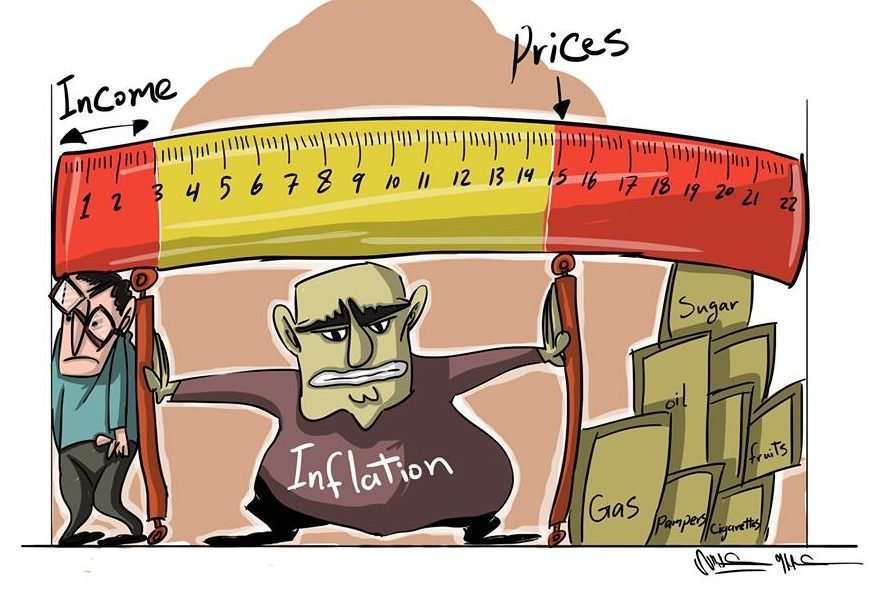What is Inflation? How much does tea cost in India? Let’s say 10rs? If you have ever travelled to Vietnam, you would end up paying at least 2000 Vietnamese dongs for the same tea. Are these Vietnamese adding elixir in tea to make it that costlier? The answer is No. There is an invisible hand in every economy which controls the prices of every commodity. Yes, you guessed it right. It is INFLATION.
The currency which is in circulation in India is called Fiat currency. Fiat currencies are such currencies which do not have any value for themselves. They are deemed to be valuable just because the Government says they are valuable. The currencies which we use on a daily basis are backed by the RBI (governor of RBI signs on every note) and RBI assigns some value to each note called Purchasing power of that note. Every good or service in the economy will have a purchasing value of their own.
If we wish to buy any good or service, we need to match the purchasing value of that good with our purchasing power. That is how transactions take place in any economy.

What is Inflation?
Inflation is defined as an increase in the price level of a group of commodities in comparison to the previous year. Let’s take the example of rice. Assume that you were able to buy a KG of rice for ₹50 in 2019. If you buy the same quantity of rice for ₹60 in 2020, then it is called price level rise. If this happens with many other commodities like wheat, dal etc.. then we consider it as Inflation (Rise in the price level of 2 or 3 items will not lead to inflation). In inflation, the currency that we hold will lose its purchasing power.
When it loses its purchasing power, you would need to spend more currency to obtain the same quantity of good/service for which you paid less value some days ago.
How does inflation fall/rise?
The fundamental laws of economics propose that when there is more demand for something, it will collect more price and vice versa. If there is more production of a particular good/service in any economy, there will be more availability of that good in markets and the price paid for that also will be less. Below are some of the factors for inflationary prices:
No.1 – Demand side factors
These are related to the consumption preferences of the public. When the public starts consuming certain products heavily, then automatically the demand will exceed the supply of that product. For example, people are demanding more oil and natural gas which is resulting in an exponential rise in price for them. If there is a substantial rise in the incomes of people, inflation also increases.
When people start earning more, they allocate more money for the consumption of goods and services rather than saving. When people start spending more, they demand more (a person may buy 10kgs of rice instead of 1 kg). This also leads to demand-supply mismatch and leads to inflation.
Sometimes, the opposite is also possible where people stay away from consuming certain products and demand is completely collapsed. In such cases where demand is virtually less or zero, deflation is expected. For example, if a study comes out saying that applying butter on bread causes cancer, people refrain from buying butter which leads to loss of demand for butter and thereby a reduction in price (deflation).
No.2 – Supply side factors
These are related to production preferences of companies. With the advancement of technology and machinery, factories are able to produce large quantities with less investment and in less time. When they produce large quantities of goods and services for less capital, the price of the goods in the market also will be less. For example, a car which cost more in the early 2000s is paid way lesser price today. Technological advancements will result in deflation.
Sometimes supply-side factors can lead to inflation too. When there are weak monsoon and meagre rainfall, the yield of crops will be reduced. The supply to market from farms will be less and it will not meet the demands of the ever-increasing population. Some unforeseen conditions like pandemic, wars, rebellions etc.. will cripple the supply chains in the economy and lead to a situation where supply is not up to the demand. Such scenarios will also lead to extreme inflation.
Is inflation bad?
Inflation is not always a bad phenomenon. A controlled rate of inflation always leads to economic growth and employment. If there is no inflation and prices stagnate at a particular number, then producers will not have any motivation to produce more and more.
Their profits will not rise above a particular figure and it makes them disappointed. An anticipated rate of inflation always gives confidence to producers to produce more and incentivize them with good profits.
This increased profits will lead to further investments and thereby increase in employment in the economy. However, uncontrollable inflation will lead to an economic crisis and chaos (example: Venezuela, Zimbabwe).
Now, coming to the question, why does tea cost more in Vietnam than in India? The answer is simple. The purchasing power of a single unit of Vietnamese currency is less than the purchasing power of a single unit of Indian currency. This is due to various demand and supply-side factors, sustainable usage of resources, the living standards of people etc.. Many developed countries managed to control their inflation rates so that purchasing power of their currencies would be intact.
India also fairly maintained its inflation rates until today. The Governments in India always wants to have controlled inflation as it is one of the stones used by oppositions to bleed ruling parties.
What are your thoughts on this? Let us know in the comments section below.
Do read and follow JUST A LIBRARY for more interesting multi-domain contents.
Stay tuned!! Stay updated!!
LIKE WHAT YOU READ? WHY NOT SUBSCRIBE?

Author – Atreya A
I am Ek aam aadmi who likes normalcy. Teaching is my passion and being a teacher I experience a sparkle in my students’ eyes that only a teacher can see. My dream is that someday people study about me.
- Follow me on Instagram – https://www.instagram.com/a_t_r_e_y_a/
- Connect on Facebook – https://www.facebook.com/atreya.amnda






